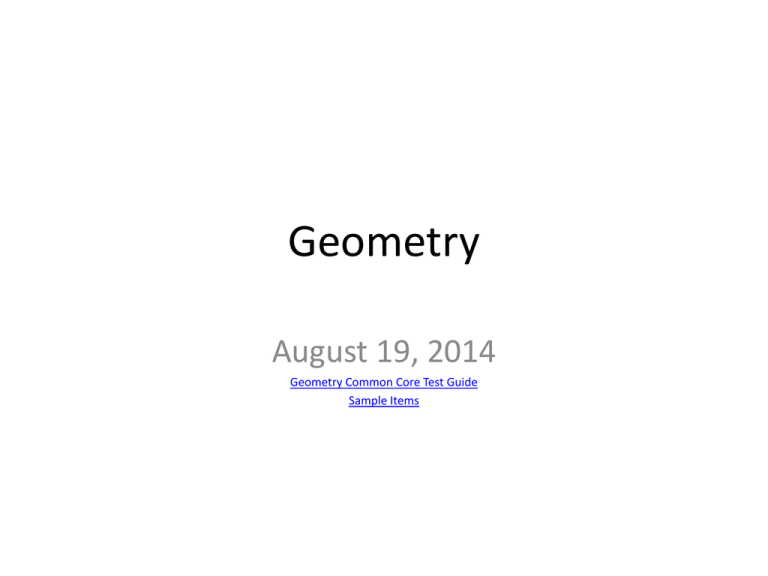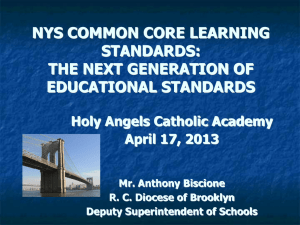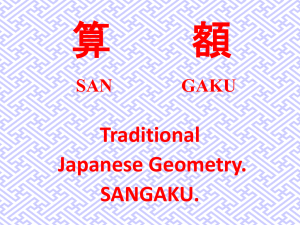
Geometry
August 19, 2014
Geometry Common Core Test Guide
Sample Items
Old or New?????
Old or New?
Old or New?
• Trees that are cut down and
stripped of their branches for
timber are approximately
cylindrical. A timber company
specializes in a certain type of
tree that has a typical diameter of
50 cm and a typical height of
about 10 meters. The density of
the wood is 380 kilograms per
cubic meter, and the wood can be
sold by mass at a rate of $4.75
per kilogram. Determine and
state the minimum number of
whole trees that must be sold to
raise at least $50,000.
• The diameter of a sphere is 5
inches. Determine and state the
surface area of the sphere, to the
nearest hundredth of a square
inch.
Agenda
Congruence
• Geometry Regents Test
Guide
• Grade 8 CCSS-Geometry
• Grade 8 Geometry Tasks
• HS CCSS-Geometry
• High School Geometry Tasks
Similarity
• Grade 8 CCSS-Geometry
• Grade 8 Geometry Tasks
• HS CCSS-Geometry
• High School Geometry Tasks
NYS COMMON CORE MATHEMATICS CURRICULUM
A Story of Functions
Key Changes in CCSS
“The concepts of congruence, similarity, and symmetry can be understood from
the perspective of geometric transformation. Fundamental are the rigid motions:
translations, rotations, reflections, and combinations of these, all assumed to
preserve distance and angles…
Similarity transformations (rigid motions followed by dilations) define similarity in
the same way that rigid motions define congruence, thereby formalizing the
similarity ideas of "same shape" and "scale factor" developed in the middle
grades.”
Common Core State Standards for Mathematics, p74
© 2012 Common Core, Inc. All rights reserved. commoncore.org
NYS COMMON CORE MATHEMATICS CURRICULUM
Regents example?
© 2012 Common Core, Inc. All rights reserved. commoncore.org
A Story of Functions
NYS COMMON CORE MATHEMATICS CURRICULUM
A Checklist of “rules”:
© 2012 Common Core, Inc. All rights reserved. commoncore.org
A Story of Functions
?
Congruence
Building From Grade 8
Definition of Translation
Definition of Reflection
•
The reflection R across a given line L,
where L is called the line of
reflection, assigns each point on L to
itself, and to any point P not on L, R
assigns the point R(P) which is
symmetric to it with respect to L, in
the sense that L is the perpendicular
bisector of segment joining P to R(P)
Definition of Rotation
•
•
•
•
•
•
Rotations require information about the
center of rotation and the degree in which
to rotate. Positive degrees of rotation move
the figure in a counterclockwise direction.
Negative degrees of rotation move the
figure in a clockwise direction.
Basic Properties of Rotations:
(R1) A rotation maps a line to a line, a ray to
a ray, a segment to a segment, and an angle
to an angle.
(R2) A rotation preserves lengths of
segments.
(R3) A rotation preserves degrees of angles.
When parallel lines are rotated, their images
are also parallel. A line is only parallel to
itself when rotated exactly 180˚.
•
The rotation Ro of t degrees (-360 < t < 360) around a given point O, called
the center of the rotation, is a transformation of the plane defined as
follows. Given a point P, the point Ro(P) is defined as follows. The rotation
is counterclockwise or clockwise depending on whether the degree is
positive or negative, respectively. If P is distinct from O, then by definition,
Ro(P) is the point Q on the circle with center O and radius |OP| so that
<QOP = t and so that Q is in the counterclockwise direction of the point P.
Geometry Course Overview
Similarity
NYS COMMON CORE MATHEMATICS CURRICULUM
Grade 8 – Module 3 – Lesson 1
© 2012 Common Core, Inc. All rights reserved. commoncore.org
A Story of Functions
NYS COMMON CORE MATHEMATICS CURRICULUM
© 2012 Common Core, Inc. All rights reserved. commoncore.org
A Story of Functions
NYS COMMON CORE MATHEMATICS CURRICULUM
© 2012 Common Core, Inc. All rights reserved. commoncore.org
A Story of Functions
NYS COMMON CORE MATHEMATICS CURRICULUM
*Lesson 2, Example 2
© 2012 Common Core, Inc. All rights reserved. commoncore.org
A Story of Functions
NYS COMMON CORE MATHEMATICS CURRICULUM
Triangle Side Splitter Theorem:
© 2012 Common Core, Inc. All rights reserved. commoncore.org
A Story of Functions
NYS COMMON CORE MATHEMATICS CURRICULUM
A Story of Functions
Grade 8 – Module 3
•Lesson 4: Lined Paper Activity leads to an
understanding of similarity.
•Similarity in terms of Dilation
•Given a dilation with center O and scale factor r,
then for any two points P, Q in the plane (when
points O, P, Q are not collinear), the lines PQ and
P’Q’ are parallel, where P’ = Dilation(P) and Q’ =
Dilation(Q), and furthermore, |P’Q’| = r |PQ|.
© 2012 Common Core, Inc. All rights reserved. commoncore.org
NYS COMMON CORE MATHEMATICS CURRICULUM
A Story of Functions
*Lesson 5: Scale Factors
Facts known:
• Ratio and Parallel Methods produce the same scale drawing.
• Triangle Side Splitter Theorem.
© 2012 Common Core, Inc. All rights reserved. commoncore.org
NYS COMMON CORE MATHEMATICS CURRICULUM
A Story of Functions
Grade 8
•Lesson 2: Properties of Dilations
• Students informally verify the properties of dilations:
•
•
•
•
Lines map to lines,
Rays map to rays,
Segments map to segments, and
Angles map to angles of the same degree.
Lesson 7: Informal Proofs of Properties of Dilations
– Optional Lesson
• *Informal proof that angles map to angles
• Informal proofs that lines map to lines, rays to rays, segments to
segments.
© 2012 Common Core, Inc. All rights reserved. commoncore.org
NYS COMMON CORE MATHEMATICS CURRICULUM
A Story of Functions
Topic C: Similarity and Dilations
•
Standards
•
•
G-SRT.2, G-SRT.3, G-SRT.4, G-SRT.5: Similarity transformations, the
AA criterion, prove theorems about triangles, use congruence and
similarity to prove relationships in geometric figures.
Key Concepts
•
•
Similarity Transformation. The composition of a finite number of
dilations and/or rigid motions.
Two figures are said to be similar if a similarity transformation exists
mapping one figure onto another. A congruence is a similarity with scale
factor 1.
© 2012 Common Core, Inc. All rights reserved. commoncore.org
NYS COMMON CORE MATHEMATICS CURRICULUM
A Story of Functions
*Lesson 15: Angle-Angle Criterion for Two Triangles to
be Similar
Theorem.
Two triangles with two pairs of equal corresponding angles are similar.
Use your handout to outline a proof of the theorem.
© 2012 Common Core, Inc. All rights reserved. commoncore.org
NYS COMMON CORE MATHEMATICS CURRICULUM
*Lesson 15, Discussion:
© 2012 Common Core, Inc. All rights reserved. commoncore.org
A Story of Functions
NYS COMMON CORE MATHEMATICS CURRICULUM
© 2012 Common Core, Inc. All rights reserved. commoncore.org
A Story of Functions
NYS COMMON CORE MATHEMATICS CURRICULUM
A Story of Functions
*Lesson 17: SAS and SSS Criteria for Two Triangles to be
Similar
© 2012 Common Core, Inc. All rights reserved. commoncore.org
NYS COMMON CORE MATHEMATICS CURRICULUM
*Lesson 17: Discussion
© 2012 Common Core, Inc. All rights reserved. commoncore.org
A Story of Functions
NYS COMMON CORE MATHEMATICS CURRICULUM
*Lesson 17: Discussion
© 2012 Common Core, Inc. All rights reserved. commoncore.org
A Story of Functions
NYS COMMON CORE MATHEMATICS CURRICULUM
© 2012 Common Core, Inc. All rights reserved. commoncore.org
A Story of Functions
NYS COMMON CORE MATHEMATICS CURRICULUM
© 2012 Common Core, Inc. All rights reserved. commoncore.org
A Story of Functions
NYS COMMON CORE MATHEMATICS CURRICULUM
© 2012 Common Core, Inc. All rights reserved. commoncore.org
A Story of Functions
NYS COMMON CORE MATHEMATICS CURRICULUM
© 2012 Common Core, Inc. All rights reserved. commoncore.org
A Story of Functions
NYS COMMON CORE MATHEMATICS CURRICULUM
© 2012 Common Core, Inc. All rights reserved. commoncore.org
A Story of Functions
NYS COMMON CORE MATHEMATICS CURRICULUM
© 2012 Common Core, Inc. All rights reserved. commoncore.org
A Story of Functions









